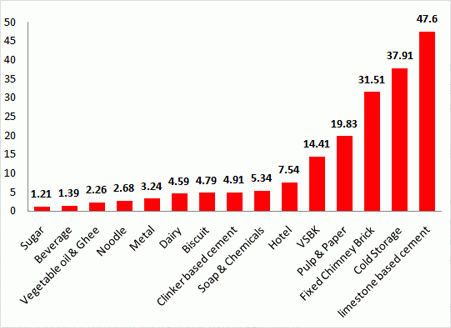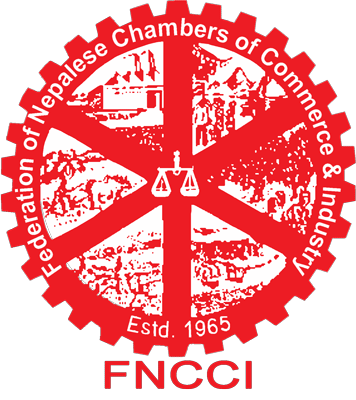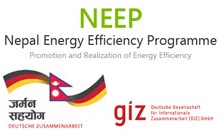Major areas for potential energy savings in Nepalese in brick kilns are:
- Improvement in heating system by installation of FD and ID fans
- Improvement in heating system by adaptation of better technology (e.g. zig zag)
- Minimization of heat losses from kiln wall, top coverage, doors
- Improvement in combustion efficiency
- Improvement in fuel feeding practice
- Proper storages of fuel
The brick sector is one of the most energy-intensive industrial sectors in Nepal. In surveyed Fixed Bull Trench Kilns (FC-BTK) energy cost is almost 32 % of product value or total turnover; in Vertical Shift Brick Kiln (VSBK) it amounts to 14 % (GIZ/NEEP, 2012).

Figure 1: Energy cost on product value in % for different industrial sectors in Nepal (GIZ/NEEP, 2012).
In total Nepalese brick kilns units could save around 5,331,018 GJ thermal energy which means coal (see Table). Considering that most coal is imported from India and contributes to Nepal's huge trade deficit, energy efficiency improvements in brick kilns would reduce coal imports at considerably rate and, thus, the trade deficit with India.
By implementing energy efficiency the sector could achieve monetary savings of about 152,642 Crore Nepalese Rupees (GIZ/NEEP, 2012).
Experience from the past have identified many options for improving energy efficiency in brick industries that are highly profitable, most of them with payback periods of investment of less than 1 year. The following table shows some implemented examples option in Nepalese brick sector with the respected payback (Danida/ESPS, 2005).
Energy Saving Tips
Brick making process has been divided into three processes:
In Nepal prominent share of firing technology is Bull trench kilns. As per experience there are significant losses which can be mitigated with small efforts. Following are the prominent areas of saving in fixed chimney brick kilns.
(1) Duct devise with double wall structure and insulation improvement( It Improve insulation and minimization of air infiltration within the kiln): In brick kiln duct, most of the brick kiln have single 14 inch wall with clay plastering results air infiltration from outside and heat loss from duct, results reduction in combustion efficiency and heat loss from the firing and soaking zone. This can be minimizing the proper wall construction .
(2) Internal fuel (Fuel mixing with clay): Internal fuel addition significantly reduces. Cheaper fuels, such as, coal slurry, coal dust, charcoal dust, and sawdust can be used as internal fuels and can help reduce fuel cost. Management of internal fuel addition is extremely difficult in the manual molding process. Semi-mechanization of moulding needs to be promoted to support use of internal fuels. Semi-mechanization of the brick moulding process would have other benefits, including an ability to use inferior clay resources and wastes, reduction in drudgery and better working conditions for workers, and potential to produce hollow and perforated bricks.
(3) Control coal feeding - Reduction in spoon size and single man firing: It can saves energy with better combustion with correct air fuel ratio. Since within the duct there is constant air flow that means coal feeding should be constant and control .
(4) Improvement in Fixed chimney BTKs to Zig Zag kilns: Zig-zag kilns appear to be the logical replacement for FCBTKs, because of low capital investment, easy integration with the existing production process, and possibility of retrofitting FCBTKs into zig- zagfiring. The zig-zag kiln performance strongly depends on the kiln operation practices; also, zig-zag natural draught kiln appear to perform better than zig-zag forced draught kiln. These aspects need further study before finalizing recommendations and formulating a large-scale dissemination programme for zig-zag kilns.
(5) Air sealing in Wicket gate (Dawari): Leakage minimization in Wicket Gate leads on (see Fig.5 & 6):
- Enhance combustion efficiency that means less energy (Coal) Consumption.
- Improvement in Brick quality
- Higher fire flow rate
Further savings can be achieved by good housekeeping measures, improvement in combustion and insulation as well as the electrical system:
- Preventive/ Scheduled Maintenance of the Plant and Machinery
- Improvement of storage system for raw materials and fuels
- Capacity building / Awareness generation of the Firemen.
- Optimization of Brick Stacking /Setting during loading.
- Optimization of fuel Feeding System and improvement of combustion efficiency
- Improvement of Insulation to minimize heat losses from kiln wall, top coverage, doors
- Fuel switching if applicable.
- Installation of Waste Heat Recovery System.
- Minimising overall distribution losses, by proper cable sizing and addition of capacitor banks
- Install delta to star convertors for lightly loaded motors
- Install timers for automatic switching ON-OFF of lights
- Install timers for yard and outside lighting
- Grouping of lighting circuits for better control
- Optimization of Water Pump system by careful selection of pumps in terms of capacity and application.
- Install maximum demand controller to optimise maximum demand
- Install capacitor banks to improve power factor
- Replace rewound motors with energy efficient motors
- Replace 40 Watts fluorescent lamps with 36 Watts fluorescent lamps
- Replace conventional ballast with high efficiency electronic ballasts in all discharge lamps
- Install LED lamps for panel indication instead of filament lamps
- Install CFL's for lighting in non-critical areas, such as, toilets, corridors, canteens etc.
- Replace V-belts with synthetic flat belts
References
- GIZ/NEEP, 2012: Baseline Study of Selected Sector Industries to assess the Potentials for more efficient use of energy.
- Danida/ESPS, 2005: Cleaner Production report of brick industry.
- Confederation of Indian Industry: Investors manual for Energy Efficiency.
- Central Bureau of Statistics (CBS), 2007: Census of Manufacturing Establishments carried out in the fiscal year 2006/07.



